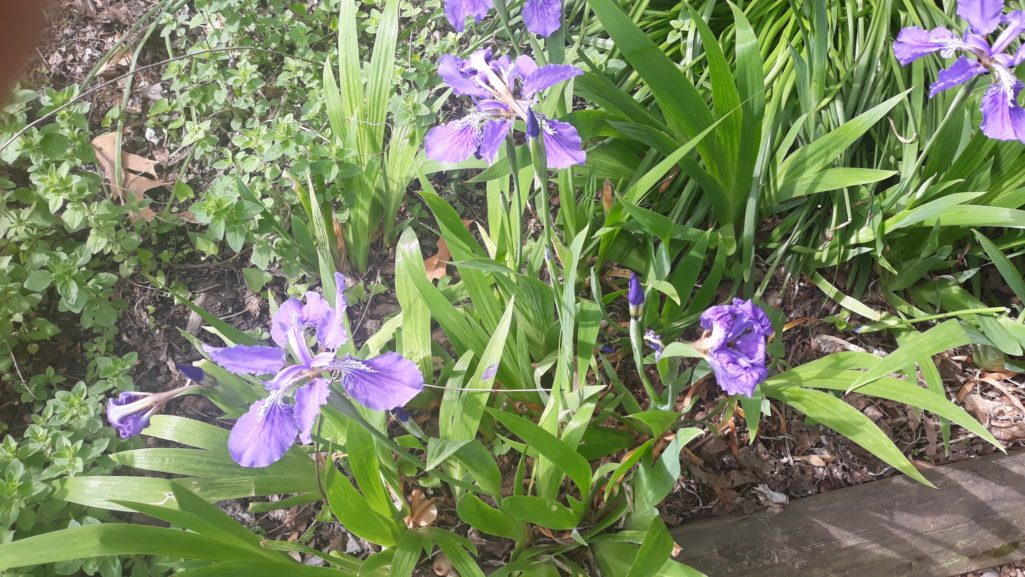
Spring and summer bring irises, almost 300 species of flowering plants which put on a show in our landscape. They take their name from the Greek word for a rainbow, which is also the name for the Greek goddess of the rainbow, Iris.
When I see irises in bloom it always makes me think of my grandmother, we called her Mamaw, whose name was Iras. Different spelling, right? I’m guessing it was an old family name but sadly, her family passed on many years ago, so there is no one left to ask. I do know that she traveled by Conestoga wagon in the early 1900s from Texas through Oklahoma, Missouri, and on to Tennessee, where she and her family settled.

I spent time with her as a child and while she was a great cook and made the best six-layer jam cake I ever tasted, I never remember that she grew irises or any other flowers for that matter. Nevertheless, the irises in my yard always bring back wonderful memories of her, green thumb or not.
My Papaw, prior to being a bootlegger and later reforming to become a church custodian, always kept a tobacco stand in their bedroom. Inside that cabinet was a supply of wild cherry cough drops. If memory serves me correctly, I remember “lifting” a few of those when I visited because to me they tasted like candy.
Even though I never got to share irises with Iras, I have been fortunate through the years to receive some from other family members including my youngest sister who once rented a home from the Prentice Cooper family in Tennessee. Cooper served as Governor of the state from 1939 until 1945. I remember the beautiful irises, the state flower of Tennessee, that were planted in the front and back of that home. My sisters and I were lucky to receive some of those transplants.

Iras’ daughter, my mother, also never really had a green thumb but she did have some irises in the front of our home in Middle Tennessee. I am blessed to have a few of those transplants from her yard blooming in mine.

Irises may be a “bearded” type or crested (“beardless”). Bearded iris is so-called because they have soft hairs along the center of the falls. Other popular varieties include Siberian and Japanese irises, Louisiana irises which are native to North America, and Dutch hybrids.
Most irises flower in late spring or early summer. They attract butterflies and hummingbirds and make lovely cut flowers.
Care for irises
Plant rhizomes of the iris in a sunny location with well-draining, rich soil for optimum flowering. Leave room for growth between the rhizomes and do not bury the entire rhizome. Make sure roots are covered, but allow the iris rhizome to remain partially above ground to avoid root rot.
Once blooms fade, leave the foliage to yellow before removing it from the flower bed. Plant so later blooming specimens cover the remaining foliage. As with many spring blooms, the foliage is sending nutrients to the rhizome for next year’s flowers. This is one of the difficult parts of iris care, as many gardeners wish to immediately remove foliage once flowering is done. Other iris plant care includes watering during dry spells, fertilization before flowers appear and deadheading of the spent blooms. However, most clumps of iris provide flowers with no maintenance. Iris is drought-tolerant, but even drought-tolerant plants benefit from occasional watering.
Exposure
Irises need full sun at least half the day. Some varieties will tolerate part shade such as Siberian irises. Many irises will grow in total shade, but they most likely won’t flower.
Bloom Time
The majority of irises will bloom in spring or summer. Dwarf varieties tend to bloom earlier in spring, with intermediate sizes blooming later spring, and taller bearded varieties blooming late spring and summer. Reblooming varieties will produce flowers once in summer and again in fall.
A rainbow of colors
There is an extremely wide variety of colors, ranging from white to almost black; although most common in shades of lavender, purple, white, and yellow.
Irises, like daylilies, are the gift that keeps on giving. They are perennial and will come back every year. They multiply and every two to three years should be divided. You can either transplant to other places in your yard or flower beds or share with family and friends.
Plant an iris in your garden. The three upright petals on an iris flower stand for faith, wisdom, and valor. Don’t we all need more of those virtues?



